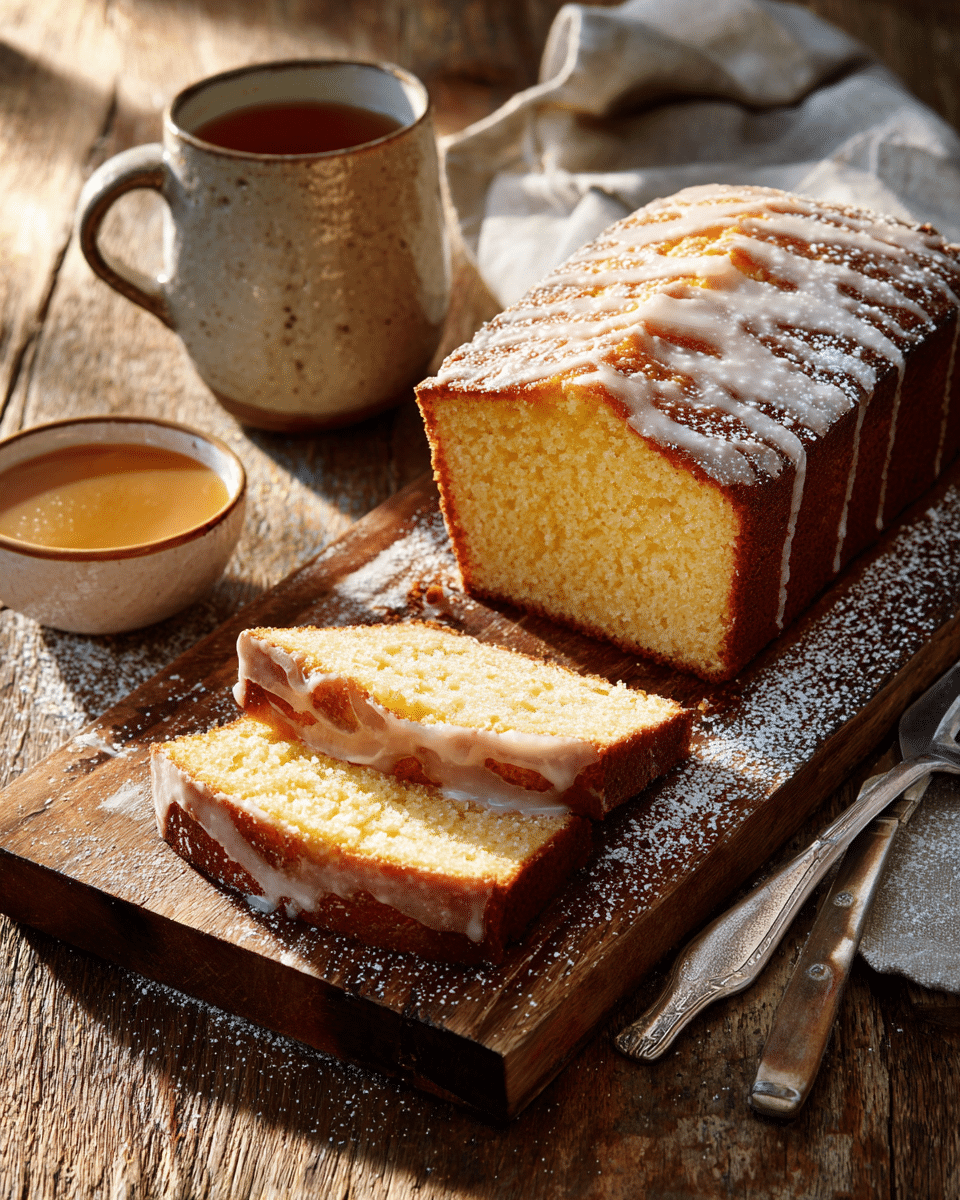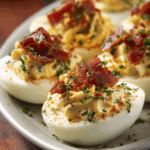This classic pound cake recipe is a treasured family favorite that’s been passed down through generations. With its dense, buttery crumb and rich vanilla flavor, Grandma’s pound cake is perfect for any occasion—from Sunday dinners to holiday celebrations. The cake’s name comes from the traditional formula of a pound each of flour, sugar, butter, and eggs, though modern adaptations create a more manageable size.
FULL RECIPE
Ingredients
- 1 cup (2 sticks) unsalted butter, softened
- 2 cups granulated sugar
- 4 large eggs, room temperature
- 1 tablespoon vanilla extract
- 3 cups all-purpose flour
- 1/2 teaspoon baking powder
- 1/2 teaspoon salt
- 1 cup whole milk, room temperature
- Optional: powdered sugar for dusting or glaze for topping
Directions
- Preheat your oven to 325°F (163°C). Grease and flour a 10-inch bundt or tube pan.
- In a large mixing bowl, cream the softened butter and granulated sugar together until light and fluffy (about 4–5 minutes).
- Add the eggs one at a time, beating well after each addition.
- Mix in the vanilla extract.
- In a separate bowl, whisk together the flour, baking powder, and salt.
- Gradually add the dry ingredients to the creamed mixture alternately with the milk, beginning and ending with the flour mixture. Mix until just combined—do not overmix.
- Pour the batter into the prepared pan and smooth the top with a spatula.
- Bake for 60–70 minutes, or until a toothpick inserted in the center comes out clean.
- Let the cake cool in the pan for 15 minutes, then invert onto a wire rack to cool completely.
- Serve plain, dusted with powdered sugar, or with a glaze or berries, if desired.
Nutrition Facts
- Calories: 420
- Total Fat: 20g
- Saturated Fat: 12g
- Cholesterol: 105mg
- Sodium: 190mg
- Total Carbohydrates: 54g
- Dietary Fiber: 1g
- Sugars: 32g
- Protein: 6g
- Calcium: 6% DV
- Iron: 10% DV
- Vitamin A: 15% DV
- Vitamin C: 0% DV
Texture and Flavor Profile
One of the defining characteristics of Grandma’s pound cake is its rich, buttery texture and subtly sweet flavor. The cake is known for its dense yet tender crumb, which melts in your mouth while remaining satisfyingly substantial. The balance of fat, sugar, and eggs provides a silky smoothness and a golden crust that adds contrast. Unlike lighter sponge or chiffon cakes, this cake leans into its richness, offering a depth of flavor that lingers with each bite. The hint of vanilla or citrus (in some variations) adds aromatic notes that complement the buttery base without overpowering it.
Best Ways to Serve Pound Cake
Grandma’s pound cake is incredibly versatile when it comes to serving. It can be sliced thick and enjoyed plain, offering a simple, nostalgic pleasure. For a fancier presentation, a dusting of powdered sugar or a drizzle of lemon glaze enhances both appearance and taste. In warmer months, serve it with a generous helping of fresh berries and whipped cream or even a scoop of vanilla ice cream. Toasting slices lightly and topping them with fruit compote also creates a delightful contrast in texture. No matter how it’s served, this cake effortlessly adapts to both casual and elegant settings.
Delicious Pairings to Enhance the Experience
Pound cake pairs beautifully with both beverages and complementary dishes. A hot cup of coffee or tea makes for a classic pairing, especially in the morning or during afternoon tea. For a richer option, try it with a cappuccino or a warm latte. During dessert time, it goes wonderfully with a glass of sweet wine like Moscato or a dessert sherry. In terms of food pairings, fresh fruits like strawberries, blueberries, or peaches bring out the cake’s sweetness, while tart sauces such as raspberry coulis or lemon curd create an exciting contrast. For holidays, serve it alongside custards or rich chocolate sauces for a decadent treat.
Popular Variations of Pound Cake
While the traditional pound cake is revered for its simplicity, there are many delightful variations to suit different tastes. Lemon pound cake is a popular twist, incorporating lemon zest and juice into the batter and glaze for a bright, tangy flavor. Chocolate lovers can opt for a marble pound cake, swirling cocoa batter into the vanilla base. Cream cheese pound cake adds extra richness and a subtle tang, while sour cream pound cake enhances moisture and softness. Spiced pound cakes with cinnamon, nutmeg, or cardamom provide warmth and seasonal charm, especially in the fall and winter months.
Tips for Achieving the Perfect Pound Cake
Perfecting a pound cake requires attention to detail and proper technique. Ingredients should be at room temperature for even mixing, particularly butter, eggs, and milk. Creaming the butter and sugar thoroughly introduces air, which helps create the right crumb structure. Overmixing after the flour is added, however, should be avoided to prevent toughness. Baking at a lower temperature, typically 325°F, ensures a gradual rise and helps avoid a cracked top or over-browned edges. It’s also crucial to use the correct pan size—usually a bundt or tube pan—to promote even cooking. Greasing and flouring the pan properly ensures easy release and preserves the cake’s shape.
Storage and Shelf Life
Pound cake stores remarkably well, making it a convenient option for baking ahead. Once fully cooled, it should be wrapped tightly in plastic wrap or placed in an airtight container to retain moisture. It can be stored at room temperature for up to 3 days or refrigerated for up to a week. For longer storage, pound cake freezes beautifully; simply wrap individual slices or the whole cake in plastic wrap followed by aluminum foil and freeze for up to 3 months. When ready to enjoy, allow it to thaw at room temperature to maintain its original texture and flavor.
Making Pound Cake for Special Occasions
This cake’s versatility and timelessness make it a perfect choice for celebrations and gatherings. It works wonderfully as a centerpiece dessert for holidays like Easter, Thanksgiving, or Christmas, especially when adorned with glaze and garnishes. For birthdays or anniversaries, it can be dressed up with layers of whipped cream and fruit or even decorated like a layer cake. Mini pound cakes or loaf-style versions make thoughtful homemade gifts, especially when wrapped in decorative packaging. Whether for a potluck, baby shower, or a quiet family dinner, Grandma’s pound cake adds a touch of homemade charm to any event.
Health Considerations and Substitutions
While pound cake is traditionally rich and indulgent, there are ways to modify the recipe for different dietary needs. Substituting part of the butter with Greek yogurt or applesauce can reduce fat while maintaining moisture. For lower sugar content, try using coconut sugar or a sugar substitute suited for baking. Gluten-free flour blends can replace all-purpose flour for those with gluten sensitivity, though some textural differences may occur. Dairy-free alternatives such as plant-based butter and nut milk can also be used, especially in conjunction with egg replacements for vegan adaptations. Each modification slightly alters the texture or flavor but still allows for a satisfying dessert experience.
Historical and Cultural Significance
Pound cake has deep historical roots, dating back to 18th-century Europe where it was prized for its simple proportions and hearty structure. It was particularly popular in Southern American cuisine, where it became a staple of Sunday suppers and church gatherings. The cake’s longevity comes from its reliability and adaptability—it uses pantry staples and requires no extravagant ingredients. Over generations, the act of making pound cake has become a family ritual, passed down through oral traditions and handwritten notes. Today, it stands as a culinary heirloom, often associated with grandmothers, holidays, and the comforting sense of home.
Advertisement
Conclusion
Grandma’s pound cake is more than just a recipe—it’s a piece of family history, rich in tradition and flavor. Its dense, buttery texture and simple ingredients are a testament to the power of time-honored baking. From the scent that fills the kitchen as it bakes to the first tender bite, this cake connects us to the warmth of loved ones and the joy of shared meals. Whether served plain or dressed up, for celebrations or everyday moments, pound cake remains a beloved classic. With its countless variations and enduring appeal, it continues to find a special place on dessert tables across generations.






